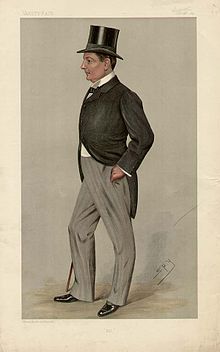Charles Spencer Canning Boyle, 10th Earl of Cork and 10th Earl of Orrery (24 November 1861 – 25 March 1925), styled Viscount Dungarvan until 1904, was an Irish soldier and peer.
The Earl of Cork | |
|---|---|
 "Sol"
Viscount Dungarvan as caricatured by Spy (Leslie Ward) in Vanity Fair, October 1897 | |
| Deputy lieutenant of Somerset | |
| In office 26 September 1885 – 25 March 1925 | |
| Appointed by | Richard Boyle, 9th Earl of Cork |
Grand Master of Masons of Somerset
 | |
| In office 1891–1925 | |
| Personal details | |
| Born | Charles Spencer Canning Boyle 24 September 1861 Grafton Street, London, England |
| Died | 25 March 1925 (aged 63) London, England |
| Spouse |
Rosalie Gray (m. 1918) |
| Relations |
|
| Parents |
|
| Military service | |
| Allegiance | |
| Branch/service | |
| Years of service | 1881–1903 |
| Rank |
|
| Unit |
|
| Battles/wars | |
Biography
editBorn to Lady Emily de Burgh and Richard Boyle, 9th Earl of Cork, on the 24 September 1861 on Grafton Street in London, England.[1] Lord Dungarvan was appointed a deputy lieutenant of Somerset on 26 September 1885,[2] and Grand Master of the Freemasons of Somerset from 1891.
He was commissioned as a Lieutenant into the North Somerset Yeomanry, a part-time regiment commanded by his father, on 1 July 1881.[3] On 5 June 1886, he was promoted to captain,[4] and on 27 May 1893 he succeeded his father as lieutenant-colonel commandant of the regiment.[5] The Second Boer War broke out in South Africa in October 1899, and following early defeats, the British government enlisted militia and yeomanry officers to increase their fighting force. Lord Dungarvan left Southampton in February 1900,[6] and arrived in Cape Town the following month. He was seconded as a major in the Imperial Yeomanry on 3 April 1901,[7] serving as second in command of the 22nd Battalion.[8] He resigned his commission on 15 January 1902, when he was granted the honorary rank of Major in the Army.[9] Later the same month he returned to the United Kingdom on board the SS Saxon,[10] and became Lieutenant-colonel on the Establishment of the North Somerset Imperial Yeomanry.[11] On 8 August 1903, he was granted the honorary rank of colonel.[12] Dungarvan resigned his Yeomanry commission on 7 November 1903, retaining his rank.[13]
He succeeded to the Earldom upon the death of his father, Richard Boyle, 9th Earl of Cork on 22 June 1904.
Lord Cork married, 21 November 1918, Mrs Rosalie Gray (d. 15 March 1930), daughter of William Waterman de Villiers, of Romsey, Hampshire, but had no issue. Lord Cork died on 25 March 1925 in London.[14] The earldom passed to his brother, the 11th Earl.
References
edit- Kelly's Handbook to the Titled, Landed & Official Classes for 1903, 29th edition, London, p. 481.
- Townend, Peter, editor, Burke's Peerage, Baronetage, and Knightage, 105th edition, London, 1970, p. 646.
- ^ Cokayne, G.E. (2000). Gibbs, Vicary; Doubleday, H.A.; White, Geoffrey H.; Warrand, Duncan; de Walden, Howard (eds.). The Complete Peerage of England, Scotland, Ireland, Great Britain and the United Kingdom, Extant, Extinct or Dormant. Vol. 3 (new ed.). Gloucester, U.K.: Alan Sutton Publishing. p. 426.
- ^ "Commission signed by the Lord Lieutenant of the County of Somerset". The London Gazette. No. 25515. 29 September 1885. p. 4558. Retrieved 29 December 2024.
- ^ Army List, various dates.
- ^ "Yeomanry Cavalry". The London Gazette. No. 25594. 4 June 1886. p. 2693. Retrieved 29 December 2024.
- ^ "Yeomanry Calavry". The London Gazette. No. 26407. 30 May 1893. p. 3121. Retrieved 29 December 2024.
- ^ "The War – Embarcation of Troops". The Times. No. 36075. London. 26 February 1900. p. 10.
- ^ "Yeomanry Cavalry". The London Gazette. No. 27304. 12 April 1901. p. 2533. Retrieved 29 December 2024.
- ^ "No. 27301". The London Gazette. 2 April 1901. p. 2290.
- ^ "War Office, Pall Mall". The London Gazette. No. 27409. 21 February 1902. p. 1204. Retrieved 29 December 2024.
- ^ "The War – movements of troops". The Times. No. 36672. London. 23 January 1902. p. 8.
- ^ "Imperial Yeomanry". The London Gazette. No. 27410. 25 February 1902. p. 1204. Retrieved 29 December 2024.
- ^ "Imperial Yeomanry". The London Gazette. No. 27586. 11 August 1903. p. 5076. Retrieved 29 December 2024.
- ^ "Imperial Yeomanry". The London Gazette. No. 27612. 6 November 1903. p. 6785. Retrieved 29 December 2024.
- ^ Hammond, Peter W., ed. (1998). The Complete Peerage or a History of the House of Lords and All its Members From the Earliest Times. Vol. 14. Sutton Publishing. p. 206.
External links
edit- Hansard 1803–2005: contributions in Parliament by Charles Boyle, 10th Earl of Cork
- . Thom's Irish Who's Who. Dublin: Alexander Thom and Son Ltd. 1923. p. 47.